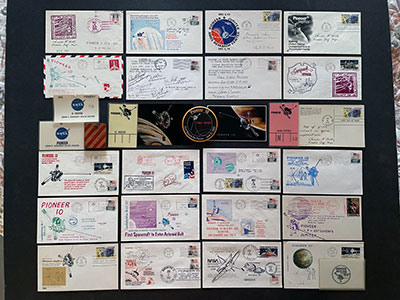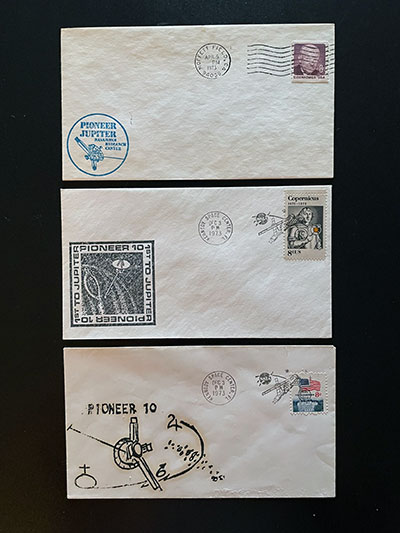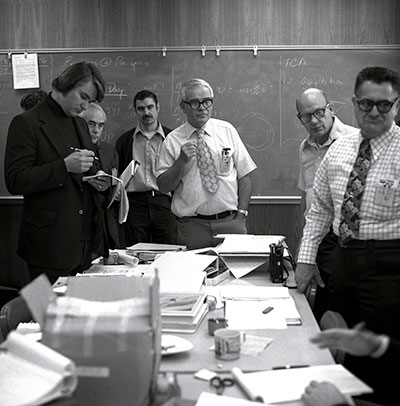|
|

|
|
Author
|
Topic: Pioneer 10 astrophilately (March 2, 1972)
|
Ken Havekotte
Member Posts: 3406
From: Merritt Island, Florida, Brevard
Registered: Mar 2001
|
 posted 03-02-2022 08:01 AM
posted 03-02-2022 08:01 AM
   
Today (March 2, 2022) marks the 50th anniversary of perhaps NASA's greatest outer space mission; Pioneer F (later named Pioneer 10 once in space). It was the first space voyage to the outer planets that made direct observations and obtained close-up images of Jupiter, the largest planet in our solar system. The Pioneer 10 space probe took measurements of Jupiter's magnetosphere, charted Jupiter's intense radiation belts, located the planet's magnetic field, and discovered that Jupiter is predominantly a liquid planet. Those measurements of the environment around Jupiter were crucial in designing the Voyager and Galileo spacecrafts that flew in 1977 and 1989. Planned for a 21-month flight to Jupiter launched by a new 3-stage Atlas Centaur (#27) launch vehicle from the Cape's Launch Complex 36A, Pioneer 10 well-out lived the spacecraft's operational life by 30 years. But the launch came within six minutes of being scrubbed a fourth time (this time by a faulty ground indicator) before a flawless liftoff at 8:49 p.m. on that Thursday of March 2, 1972. For me personally, as a high schooler, the launch of AC-27 with Pioneer 10 tucked away near the top of the rocket, was another early opportunity to witness up-close a live liftoff as an invited guest by NASA's Unmanned Launch Operations directorate. The 9-foot long and wide robotic space machine, weighing 569 pounds when launched, was built by the TRW Space & Technology Group of Redondo Beach, CA, under a $150 million contract from NASA's Ames Research Center in Moffett Field, CA. Here are some of the extraordinary accomplishments of this incredible space journey that had been so far away from Earth: - First spacecraft to fly into interstellar space
- First to fly beyond the red planet Mars
- First to fly through the asteroid belt
- First to pass Jupiter at 81,000 miles above the cloudtops
- First to cross the ring planet Saturn's orbit
- Crossed the orbit of planet Neptune to become the first human-made object to go beyond Neptune
- First space trip unmatched by any other robotic space vehicle to date
Pioneer 10, with an initial speed of just over 32,000 mph, will continue to coast silently as a ghost ship through deep space heading in the region of the red star Aldebarab, which forms the eye of Taurus (The Bull) star constellation. The red star is about 68 light years away and will take Pioneer 10 over 2 million years to reach it. It's last signal back to home planet Earth was in Jan. 2003 from a distance of 7.6 billion miles. In celebrating the probe's golden anniversary, the postal cover display above depicts some of my favorite Pioneer 10 covers, along with a few original mission badges, a rare pinback, and a Pioneer 10 first day cover issue by spacecraft builder TRW. As you can see, many types of different cachet covers were produced for this remarkable spaceflight voyage. There are even a couple of official NASA rubber stamps by Ames Research Center along with a printed cachet cover of theirs. Several of the covers are signed, mostly by Charles F. Hall, the Pioneer 10 project manager at Ames. Other Pioneer 10 cachet makers are by Cygnus, Space Voyage Covers, Whitney, InterSpace, Centennial Covers, Artopages, ROMA, and with a few tracking station covers from Barstow, CA, and Madrid, Spain, in this assortment selection. The Kennedy Space Center postal department reported that less than 2,000 pieces of space mail received Pioneer 10 actual launch day cancels on March 2nd. It appears that many more covers had received a March 3rd cancel — both from KSC/CC — as it should be noted that post offices were closed at the liftoff time. But covers can be held in advance for a proper day cancellation, therefore, why are there so many cancel dates on the 3rd and not the 2nd? Less than a couple thousand covers are not that many from KSC by those standards during the early 1970's, however, the launch pad for Pioneer 10 was on the Cape-side and not KSC. On the 3rd, the space probe raced beyond the moon in record time and measured the earth's radiation belts as it cruised to Jupiter more than 600 million miles away. For the most part, though, it would seem the majority of launch day covers for Pioneer 10 were cancelled a day later and not on March 2nd, including from other major Florida Space Coast areas such as Patrick AFB and Satellite Beach. Check over your own Pioneer 10 launch day covers to see what cancel date is on them. It would appear that March 2nd postal strikes are not as common as one would think for such a milestone space event as this. |
Bob M
Member Posts: 1809
From: Atlanta-area, GA USA
Registered: Aug 2000
|
 posted 03-02-2022 10:54 AM
posted 03-02-2022 10:54 AM
   
Thanks, Ken, for a fascinating account of Pioneer 10's amazing history and accomplishments and for such an impressive display of Pioneer 10 memorabilia. As mentioned, after passing by Mars, then through the Asteroid Belt, then passing Jupiter, Saturn and Neptune, its next encounter will be the region of the red star Aldebarab in just 2 million years! A very lonely and unbelievably long journey that should go on forever. |
Ken Havekotte
Member Posts: 3406
From: Merritt Island, Florida, Brevard
Registered: Mar 2001
|
 posted 03-02-2022 06:16 PM
posted 03-02-2022 06:16 PM
   
It should be noted that there is another official NASA Ames Research Center rubber stamp cachet used on Pioneer space covers (top view) in addition to the middle-cover image (in black ink instead of red). The last illustrated cover is a mystery to me as it appears to be a "burnt-in" cachet application of a design that I am not familiar with. Anyone know more about it? I have also seen the first two cachet designs used on the outside of mailing envelopes from ARC as official routine mail during the early 1970's.For Bob, appreciate the comments, and do your Pioneer 10 covers have the correct launch day?  |
Bob M
Member Posts: 1809
From: Atlanta-area, GA USA
Registered: Aug 2000
|
 posted 03-03-2022 10:01 AM
posted 03-03-2022 10:01 AM
   
Unfortunately, my Pioneer 10 launch covers all have the later March 3, 1972 date. But I do have a cover/cachet type you've not shown. It has a printed red cachet picturing Pioneer 10 from the Space City Cover Society. It has an additional hand cancel from Cape Canaveral on June 13, 1983, marking Pioneer 10's historic departure from the Solar System. |
yeknom-ecaps
Member Posts: 768
From: Northville MI USA
Registered: Aug 2005
|
 posted 03-03-2022 11:19 AM
posted 03-03-2022 11:19 AM
   
quote:
Originally posted by Ken Havekotte:
The bottom two covers seem to commemorate the first launch anniversary of Pioneer 10 in March 1973.
The bottom two covers are postmarked December 1973 for the Pioneer 10 Jupiter fly-by. |
Ken Havekotte
Member Posts: 3406
From: Merritt Island, Florida, Brevard
Registered: Mar 2001
|
 posted 03-03-2022 12:07 PM
posted 03-03-2022 12:07 PM
   
Thanks Tom for that correction as I did have the same-day posted covers seen above in the montage for Jupiter's fly-by. I went ahead and deleted that sentence.Anyway, I have only seen covers in my own collection with March 2nd launch day cancels by Space Voyage, Cygnus, and a home-made rubber-stamp/type written cachet. Oddly enough, those covers all have KSC 3-2-72 cancels, but I can't seem to find any other covers that I know of with CC, PAFB, or SB with March 2nd cancels. One of the Centennial Covers, posted March 3rd at KSC, does have an added 2-line rubber stamp with the text on it, "CANCEL DELAYED--Launching after P.O. closed." Normally, as a cover servicer here on the Florida Space Coast, you could easily just drop off your covers that same day before 5 pm and request a PM cancel if a launch had occurred that evening before 12-midnight. Though not a big deal or anything, but it just has me curious, so I'll check on this further. Meanwhile, what other cachet makers were able to acquire "same day" launch cancels for Pioneer 10?
|
rvk
Member Posts: 30
From: Highlands Ranch, CO USA
Registered: Jul 2020
|
 posted 03-03-2022 03:29 PM
posted 03-03-2022 03:29 PM
   
Ken, Thank you for reminding me how LONG AGO it was when I worked on the Pioneer 10/11 Program. I started working on the Pioneer program in the early seventies as a spacecraft mission controller at our backup mission control center at the Jet Propulsion Laboratory (JPL) in Pasadena, CA. I was later transferred to the primary mission control center at NASA Ames Research Center in Bldg. 244. Working on interplanetary missions is very educational, especially when you are going to a planet that no one has been to before. Something they do not teach you in college. Those were interesting times. |
Ken Havekotte
Member Posts: 3406
From: Merritt Island, Florida, Brevard
Registered: Mar 2001
|
 posted 03-03-2022 04:33 PM
posted 03-03-2022 04:33 PM
   
Thanks for posting of your key Pioneer 10/11 controller-engineering positions while at JPL and ARC during the early 70's. I envy you so much in having such unique "hands on" opportunities in having been part of the Pioneer team at both flight control centers. Did you note two of the signed covers in the first panel display by mission personnel that were working inside the Pioneer Operations Center and the Space Sciences Building at ARC when Pioneer 10 left the solar system? Wouldn't it be something if one of those signatures was actually yours in June 1983, but I don't think you were still at ARC during the early 80's. Perhaps you may have known some of the folks that did sign? Again thanks for sharing and it had to be a very exciting time-era for you personally. |
Bob M
Member Posts: 1809
From: Atlanta-area, GA USA
Registered: Aug 2000
|
 posted 03-03-2022 04:51 PM
posted 03-03-2022 04:51 PM
   
"RVK" stated that those were exciting times and certainly were for him being so directly involved in our space program and sending early spacecraft to the planets and (way) beyond, but they were also exciting times for us space cover collectors and a great time to be a space fan and especially a collector. In my opinion, the 1960's, '70's, '80's and '90's were the Golden Age of space cover collecting. |
rvk
Member Posts: 30
From: Highlands Ranch, CO USA
Registered: Jul 2020
|
 posted 03-04-2022 03:44 PM
posted 03-04-2022 03:44 PM
   
Ken, those two signed covers do have signatures of the managers and scientists I worked with. I saw Charles Hall and Dr. Richard Fimmel almost every day and also Robert "Skip" Nunamaker and Robert "Bob" Hogan along with the other scientists that checked with us on the spacecraft status from time to time. You will not see my signature on any envelope from that time since I was only a mission controller and not one of the higher-level managers. I am also attaching a black/white photo of some of the management team at the Pioneer Project. Skip Nunamaker is on the far left side, Charles F. Hall is in the middle, and Dr. Fimmel is on the far right side.  By the way, the red cachet on the envelope in the upper left corner was issued by the Public Affairs Office (PAO) at NASA ARC. The Pioneer Saturn 1979 cachet at the bottom, serial number 284, is my artwork that I designed for the NASA ARC Stamp Club. Very nice display of covers. For more information on the Pioneer Jupiter Mission, I recommend the NASA publication SP-349 "Pioneer Odyssey." This was available awhile ago in print but is also available online at NASA here. In Appendix 3 there is a section under "Contractors" where you will see my name under Kapp, Richard V. And you are correct about my not being at NASA ARC in the early 80's. Lockheed Martin hired me away in 1979 to work next door at the Air Force Satellite Control Facility (AFSCF), Sunnyvale AFS, to work on government spacecraft systems. That facility was also referred to as the "Blue Cube" and was near Moffett Field. Again, my thanks to you for reminding me how old I am. |
Ken Havekotte
Member Posts: 3406
From: Merritt Island, Florida, Brevard
Registered: Mar 2001
|
 posted 03-11-2022 04:54 PM
posted 03-11-2022 04:54 PM
   
Great photo Richard and enjoyed your latest posting. Let me email you a bit later on. | |
Contact Us | The Source for Space History & Artifacts
Copyright 2022 collectSPACE.com All rights reserved.

Ultimate Bulletin Board 5.47a
|
|

|
 advertisement advertisement

|














